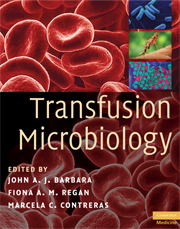Book contents
- Frontmatter
- Contents
- List of contributors
- Foreword
- Preface
- Acknowledgements
- Glossary
- Introduction: Transfusion-transmitted infections, then and now
- Section 1 Agents
- Section 2 Selection and testing
- 10 Blood donor selection and qualification
- 11 Current serological methods of testing and automation
- 12 Confirmatory testing and donor re-admission
- 13 The strategy for applications of nucleic acid testing
- 14 Nucleic acid testing: general view
- 15 Nucleic acid testing: the US approach
- 16 Nucleic acid testing: the UK approach
- 17 Quality in the screening of donations for transfusion-transmissible infections
- 18 Microbiological blood testing and new technologies
- 19 Processing and components: leucodepletion and pathogen reduction
- 20 Fractionated products
- Section 3 Surveillance, risk and regulation
- Index
- Plate section
- References
12 - Confirmatory testing and donor re-admission
from Section 2 - Selection and testing
Published online by Cambridge University Press: 12 January 2010
- Frontmatter
- Contents
- List of contributors
- Foreword
- Preface
- Acknowledgements
- Glossary
- Introduction: Transfusion-transmitted infections, then and now
- Section 1 Agents
- Section 2 Selection and testing
- 10 Blood donor selection and qualification
- 11 Current serological methods of testing and automation
- 12 Confirmatory testing and donor re-admission
- 13 The strategy for applications of nucleic acid testing
- 14 Nucleic acid testing: general view
- 15 Nucleic acid testing: the US approach
- 16 Nucleic acid testing: the UK approach
- 17 Quality in the screening of donations for transfusion-transmissible infections
- 18 Microbiological blood testing and new technologies
- 19 Processing and components: leucodepletion and pathogen reduction
- 20 Fractionated products
- Section 3 Surveillance, risk and regulation
- Index
- Plate section
- References
Summary
Introduction
The major focus in ensuring the microbiological safety of the blood supply relies heavily on the primary screening of donated blood. Although routine donor screening assays are highly sensitive, this sensitivity is often achieved at the expense of specificity (0.05–0.5%) (Dow, 2000).
Blood donations found to be initially reactive at donor testing sites should be repeat tested in duplicate. Should any of the repeat tests result in reactivity, the donation is classified as ‘repeatedly reactive’, the donor is flagged on the donor database and samples are submitted to the designated national reference laboratory or other designated facility. Regardless of confirmatory test results, the donation and all its associated components will be excluded from transfusion.
Throughout the world, blood services have differing policies with regard to confirmation of microbiology reactive donations. Most developed countries' services are capable of performing adequate confirmation of reactive donations. However, some services use an alternative strategy of reporting reactivity directly to the donors, often resulting in considerable donor anxiety and potential personal expense to reach a confirmatory conclusion. Obviously, in areas of high endemicity, there is a higher predictive value associated with a repeat reactive result and in this situation, simpler confirmatory algorithms can be utilized. Generally though, in developed countries, donors have relatively low prevalences of infection and therefore more complex confirmatory algorithms, like those described in this chapter, are often necessary before notification to the apparently healthy volunteer donor.
- Type
- Chapter
- Information
- Transfusion Microbiology , pp. 173 - 182Publisher: Cambridge University PressPrint publication year: 2008



